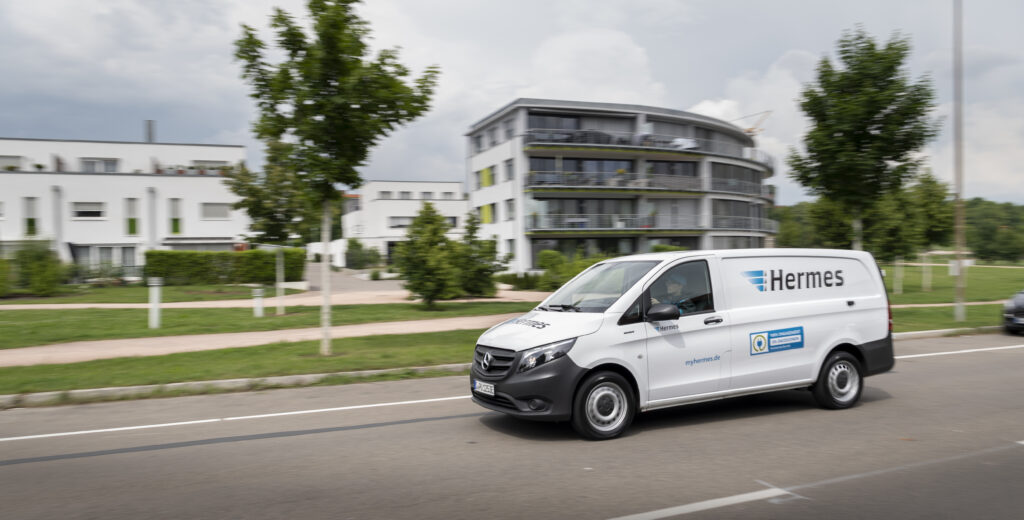Hermes has ordered 168 fully electric Mercedes-Benz eSprinters and 132 diesel-engined Sprinter 315 CDi variants to add to its fleet in the UK.
The Mercedes-Benz eSprinter is powered by a 114hp electric motor that drives the front wheels. It will travel 95 miles (combined WLTP with 80km/h speed limiter) on a single charge, which is ample for the majority of urban delivery and last-mile applications. Recuperative energy recovered when decelerating supplements the batteries’ output.
The vehicle is based on the L2 (medium-length), H2 (high-roof) Sprinter. Its 55kWh high-voltage battery pack is securely mounted beneath the body, so does not impinge on cargo carrying space. As a result, the eSprinter’s 11m3 load volume is identical to that of its diesel-engined, front-wheel-drive stablemate, and 0.5m3 larger than its rear-wheel-drive equivalent.
When specifying diesel Sprinters, Hermes has opted for the long-bodied L3 H2 variant, which offers a 14m3 load volume. The reduced parcel carrying capacity of the L2 eSprinter compared with the L3 version represents the biggest operational compromise that Hermes will have to make. Initially, therefore, it will be allocating the electric vans to those routes best suited to their smaller cargo areas and restricted range.
The company says that it only ordered the diesel vans to “tide it over”, pending completion of its infrastructure program and the introduction of battery-powered variants. Thus, while its first eSprinters will be the subject of longer Mercedes-Benz finance contract hire agreements, the Sprinter 315 CDis will be on one-year terms with Athlon UK, which is owned by Mercedes-Benz parent Daimler AG. This arrangement will enable Hermes to replace the diesels once charging facilities are in place and electric versions with longer ranges and higher carrying capacities become available.
Hermes plans to undertake all ParcelShop collections with electric vehicles at the earliest opportunity. The ParcelShop business currently stands at some 450 units but is growing and supplemented with rented vehicles during busy periods. The owned fleet includes 30 smaller electric vans that work from a depot in East London, while French-built diesels will be stood down to make way for the eSprinters.
The zero-emission vans are intended to be on the road before the end of 2021. They will be assigned to Hermes’ popular pickup and drop-off service, ParcelShops, which operates from more than 5,000 convenience stores and other locations nationwide.
Hermes has commissioned Pod Point to install charging points at its network of depots. While the vehicles will be recharged overnight, the van provider, Intercounty Truck & Van, is also using Hermes’ ParcelShop routing data to plot additional points at which they can be replenished – using an 80kW DC fast-charging cable, the eSprinter’s four parallel batteries can be restored from 10% to 80% of maximum capacity in just 30 minutes. This work is already underway, with the focus initially on those in London and other cities that have introduced low emission zones.
David Landy, head of fleet at Hermes, said, “The transition to a zero-emission, electric fleet will not be an easy journey. From a purely operational standpoint, whichever way you look at it – whether in terms of range, payload or volume – a van with an internal combustion engine beats an electric one hands down. Only when it comes to tailpipe emissions does the battery-powered vehicle outshine the diesel. So we know that this is going to put extra pressure and increased demands on those colleagues out in our depots.”
Landy also acknowledged that the electric revolution was still in its infancy, and that Hermes would face fewer operational challenges as Mercedes-Benz Vans’ zero-emission product range evolves: “This technology is moving so fast that the vehicle we’re about to start putting to work will not be the vehicle we’re still running in a year or two’s time,” he said. “Not only does the agreement we’ve reached with Mercedes-Benz Vans mean we can swap out diesel vans for more battery-powered ones as our charging infrastructure program progresses, but it also allows us to transition our first electric vans to new-generation versions that will cover greater distances and carry more as these become available.”


